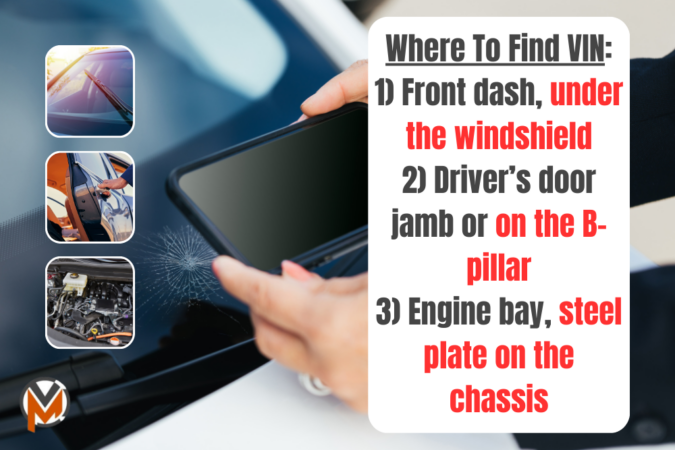Whether your car’s been stolen, or if you want to track down a car you regret selling and want it back, there are some easy ways you can track your car by using its VIN number. These include getting a Carfax report done on it, relying on VIN tracking and decoding services, or even calling the police (among others). These can help track down that car of yours.
Trying to track a vehicle by its VIN number isn’t straightforward, but it can help you narrow down your car’s location, or at least where it’s ended up. Your car’s VIN (or “Vehicle Identification Number“) is a unique serial and sequence of numbers that is given for every road-legal vehicle out there. There are no two cars with the same VIN.
What Is A Vehicle Identification Number (VIN)?
The VIN is a mixture of letters and numbers that basically functions as the ID of your car. Unlike other pieces of information, such as a car’s registration, the VINs are created specifically to identify vehicles by their color, trim level, year of production, production plant, and other information that’s extremely useful for jotting down a car’s history.
You cannot track the car’s history by a license plate. A car can have dozens of license plates if it changes owners through the years. But it cannot have dozens of VINs. The VIN is one and only, distinct for each car, and you cannot change it. In that way, a car’s VIN is similar to a social security number, and could also be somewhat seen as a car’s birth certification.
VIN (Vehicle Identification Number) Location
The first and most obvious place where to look for your VIN would be the title of the car. If you are the legal owner of a specific vehicle, you should also have the certification of title as proof of ownership. Look through your documents and find the title. There will be the VIN written, and based on this information you can jump online and start looking for the car.
Other than the title, the other place that you might want to take a look at is the front dash. Namely, the driver’s side. There, under the windshield, the VIN should be stamped. If you cannot find it here, you might want to take a look at the driver’s door as well as the B pillar. There should be stickers that indicate the VIN as well as other information.
The next place that you might want to look at is the engine bay. There should be a steel plate that is attached to the chassis that has the VIN on it. Overall, these are the most probable locations where you can find the VIN. However, it’s worth bearing in mind that some automakers are sneakier with hiding the VIN number, and it’s not always easy to find.
How To Track My Car By VIN?
One very important bit of caveat we need to consider first – locating a car’s exact location based on a VIN is impossible. You might get a hold of the vehicle’s history and the city in which the car was last registered and that’s about it. It’s not a GPS tracker, that’s vital to understand. You cannot get the location of the vehicle just by knowing the VIN!
With that being said, being able to at least approximate where your car might be, could still prove worthwhile. Whether your car was stolen, or if you just want to check its sales history, and maybe you want to know if it’s been stolen, lost, or salvaged in the past, learning how to track a vehicle by its VIN number can still be handy.
1. Find Your VIN Number
The first thing you ought to do is find and record the VIN number. This can be located on the car itself or in your car’s ownership paperwork. If you don’t have the title, you’ll need to rely on the VIN plate on your car, which has its challenges. Sometimes, these VIN plates can get worn, rusted, and damaged, which makes reading them a bit harder.
Then, once you have the VIN, you can try your luck and get a Carfax report on it. Carfax is a website where you can dive into the vehicle’s history and past, and see what you can find on that specific vehicle. Many used car marketplaces, like Autotrader (among many others), offer free Carfax reports for the vehicles that are sold there.
If your car was stolen let’s say, there are also other websites that you can use to track the car by VIN, such as the one offered by the NICB. Here, you can get history reports from the past 5 years and see if the car was lost, stolen, or salvaged and in some cases, it will show the current location if the location is available. So, you might want to give it a try.
2. File A Report To The Police If Your Car Was Stolen
Another way to track your car by VIN is to file a report to the police and let them know that your car was stolen. For this, you will be required to have your title, registration documents, and also the VIN that is located on the title. This, along with the registration number is the most important when it comes to locating your car across the country.
The car could be a few states away, for example. So, it might be a little bit difficult to find it, and it may take some time for the police to take action. If you want to speed things up, you might want to mix and match with the first method above, to expedite the process. Knowing the place where your car is approximately located, will speed up the search for your car.
3. Check Auction Sites Where Your Vehicle Might Get Listed
If your car got stolen and you cannot find it, you might want to take a look at websites that have car auctions like Copart. Any sort of marketplace or auctioning site is prime territory to start searching because your car might pop up over there. In fact, having your car auctioned off could entirely be a totally innocent accident on the part of the authorities.
For instance, maybe your car was stolen and was found by the police. But, the police couldn’t locate the owner of that car if there were no license plates. So, consequently, the car could’ve ended up at auction. Keeping your eye on the auctions is key if you want to find a lost car. Because you never know what you will see over there. There are a ton of cars that are salvaged.
4. Spread The Word On The Internet
Another way to track your car by VIN is to spread the word over the web, and hope that internet sleuths could help out. There are a ton of Facebook groups about tracking down stolen vehicles. If your car has been seen online (images, videos, etc.), there could be someone out there who’ll notice it. And once they’ve noticed it, inquiries will be made about where it’s located.
Once you and other folks on the internet have somewhat pointed to where your car might be located, things will become more straightforward. You could call the local authorities and tell them that your car is there. Additionally, give them the VIN and other information and they’ll use them to find your car in no time, and prove its ownership back to you.
There are numerous automotive forums where enthusiasts discuss cars, share stories, and sell vehicles. Posting about your stolen vehicle, along with its VIN number, might get you valuable leads from other members of the community and forum at large. Members often come across various deals on cars on offer or are being sold, and they might spot your vehicle.
5. Use VIN Tracking Websites
While Carfax remains a popular choice, there are many other websites like AutoCheck, VINCheck, and VINDecoder that offer detailed histories of vehicles by simply entering the VIN number. These sites can provide ownership history, accident reports, and locations where the car has been registered, among countless other details.
By keeping a regular check, you can spot any unusual activities and possibly even trace your vehicle. Sometimes, when a stolen vehicle gets serviced by a workshop or mechanic, they might run a VIN check on it. If that car’s VIN was flagged as stolen, they’ll notify the authorities. Keeping local dealers informed might prove fruitful, as well.
Specifically, stolen cars might be brought into repair shops for parts replacement or servicing. By informing local repair shops and garages about your stolen vehicle with its VIN, they can be on the lookout and notify you or the police if such a car arrives. Print out details with the VIN and distribute them; a physical reminder often helps mechanics to remember.
6. Contact Your Insurance Provider
While you might think of contacting your insurance company only for filing claims against damage, they can also assist in tracking down stolen vehicles. Sometimes, stolen vehicles are involved in accidents or other incidents. By having your vehicle’s VIN flagged in their system, they can alert you if any claim is made on that vehicle.
Insurance companies often receive claims for damages. If someone’s trying to get your stolen car insured or has made a claim, the company will have that data. Collaborating with them can provide you with a lead. Some insurance providers even offer GPS tracking services to pinpoint a car’s location if it’s been stolen. So, if you have that, it’ll help out a lot.
7. Keep an Eye on Local Car Dealerships
Thieves sometimes attempt to sell stolen cars to dealerships. By notifying local car dealers about your stolen car and providing them with the VIN, they can be more vigilant and inform you if a similar car comes their way. Cars are often traded in for newer models. Make sure local dealerships are aware so they can check the VIN of cars being traded in.
Decoding A VIN Number
A Vehicle Identification Number (VIN) is not just a random set of characters. It’s a coded guide to your car’s unique identity. It gives details about its manufacturer, model, and the year it rolled off the assembly line. So, before diving into the decoding process, let’s understand its structure.
A VIN has 17 characters. Here’s a brief overview:
- Characters 1-3: World Manufacturer Identifier (WMI)
- Characters 4-8: Vehicle Descriptive Section (VDS)
- Character 9: Check digit
- Character 10: Model year
- Character 11: Assembly plant
- Characters 12-17: Vehicle Identifier Section (VIS)
Let’s decode these sections and explore them a bit further:
1. World Manufacturer Identifier (WMI)
The first three characters reveal who made the car and where.
- First Character: This indicates the region where the car was manufactured. For example, cars made in the US start with 1, 4, or 5.
- Second Character: Highlights the manufacturer. For Ford, it’s ‘F’; for Chevy, it’s ‘G’.
- Third Character: Represents the vehicle type or manufacturing division.
2. Vehicle Descriptive Section (VDS)
This portion tells you specifics about the vehicle’s type, body, and series.
- Characters 4-5: Show the model or series.
- Characters 6-7: Indicate the body style, like sedan, coupe, or convertible.
- Character 8: Pinpoints the engine type.
3. Check Digit
The ninth character is a unique formula-derived number or letter for error checking. It’s a way to validate the VIN for authenticity.
4. Model Year
The tenth character signifies the model year of the car. Each year has a specific code. For instance, ‘Y’ was for 2000 and ‘A’ for 2010. The codes cycle every 30 years.
5. Assembly Plant
This is a single character that stands for the factory where your car was assembled. Each manufacturer has a unique set of codes for its plants.
6. Vehicle Identifier Section (VIS)
The final six characters give individual info about the car.
- Characters 12-14: These often relate to the model or series.
- Characters 15-17: These are unique to each vehicle. They’re the sequential number the car received when it rolled off the assembly line.
And, to test out what we’ve learned with how to track your car by VIN, here’s an example VIN: 1HGCM82633A004352.
- 1HG tells you the car was made in the US by Honda.
- CM826 could mean it’s a Honda Accord V6.
- ‘3’ is the check digit.
- ‘A’ indicates it’s a 2010 model.
- The assembly plant is 0.
- 04352 is its unique number on the assembly line.




I would like to know would you be able to find me someone to track for me my stolen car via Vin no?
I’m sorry to hear about your stolen car, Zola. Unfortunately, tracking a stolen car by its VIN number is not possible. The VIN (Vehicle Identification Number) is a unique identifier assigned to each vehicle, but it is primarily used for administrative purposes such as registration and maintenance records. It does not have the capability to track a vehicle’s location. However, if you haven’t already, I would strongly recommend contacting the authorities and providing them with all the necessary information about your stolen car, including the VIN number. They have the resources and expertise to assist you in recovering your vehicle.
Looking for my CRV
Hi Michael,
While the VIN is important for vehicle identification and documentation purposes, it is not designed for real-time tracking or location services.
If you need to track a CRV or any other vehicle, it typically requires the use of specialized tracking devices or services, such as GPS tracking systems. These devices can be installed in a vehicle, and they allow authorized individuals or organizations to monitor the vehicle’s location, speed, and other parameters. Such tracking systems are commonly used by businesses with fleets of vehicles, car rental companies, and law enforcement agencies for various purposes.
If you have concerns about a vehicle’s location or need assistance with tracking for legitimate reasons, it’s advisable to contact the appropriate authorities or seek professional help from experts in the field.